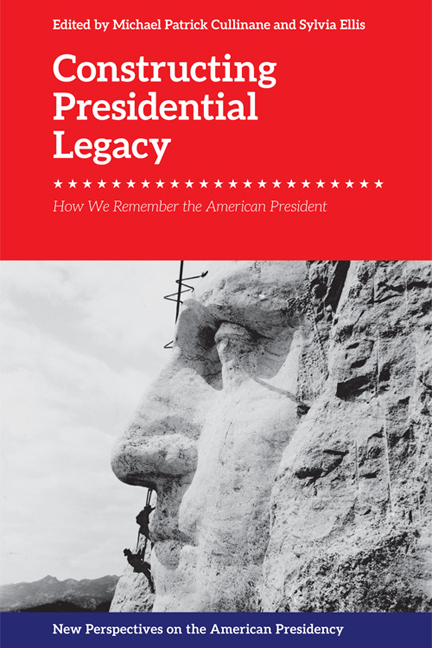Book contents
- Frontmatter
- Contents
- Acknowledgments
- Notes on Contributors
- An introduction to Presidential Legacy
- 1 Presidential Temples: America’s Presidential Libraries and Centers from the 1930s to Today
- 2 Presidential Legacy: A Literary Problem
- 3 Pennsylvania Avenue meets Madison Avenue: The White House and Commercial Advertising
- 4 Eisenhower’s Farewell Address in History and Memory
- 5 Pageantry, Performance, and Statecraft: Diplomacy and the Presidential Image
- 6 “You’ve got to decide how you want history to remember you”: The legacy of Lyndon B. Johnson in film and Television
- 7 The Farewell Tour: Presidential Travel and Legacy Building
- 8 Reflecting or Reshaping?: Landmark Anniversaries and Presidential Legacy
- 9 From a “New Paradigm” to “Memorial Sprawl”: The Dwight D. Eisenhower Presidential Memorial
- 10 Top Trumps: Presidential Legacies, New Technologies, and a New Generation
- Epilogue: Confessions of a Presidential Biographer
- Index
5 - Pageantry, Performance, and Statecraft: Diplomacy and the Presidential Image
Published online by Cambridge University Press: 01 May 2021
- Frontmatter
- Contents
- Acknowledgments
- Notes on Contributors
- An introduction to Presidential Legacy
- 1 Presidential Temples: America’s Presidential Libraries and Centers from the 1930s to Today
- 2 Presidential Legacy: A Literary Problem
- 3 Pennsylvania Avenue meets Madison Avenue: The White House and Commercial Advertising
- 4 Eisenhower’s Farewell Address in History and Memory
- 5 Pageantry, Performance, and Statecraft: Diplomacy and the Presidential Image
- 6 “You’ve got to decide how you want history to remember you”: The legacy of Lyndon B. Johnson in film and Television
- 7 The Farewell Tour: Presidential Travel and Legacy Building
- 8 Reflecting or Reshaping?: Landmark Anniversaries and Presidential Legacy
- 9 From a “New Paradigm” to “Memorial Sprawl”: The Dwight D. Eisenhower Presidential Memorial
- 10 Top Trumps: Presidential Legacies, New Technologies, and a New Generation
- Epilogue: Confessions of a Presidential Biographer
- Index
Summary
In November 1943, US President Franklin Roosevelt was photographed in Tehran with the leaders of the Soviet Union and Great Britain, Joseph Stalin and Winston Churchill. The picture of FDR, seated in his dark pinstripe suit flanked by Stalin and Churchill in military uniforms, became one of the iconic images of World War II, helping to cement both the concept of the “Big Three” and Roosevelt's status as a great statesman. More than forty years later another president, Ronald Reagan, welcomed Prince Charles and Princess Diana of Great Britain to a star-studded state dinner at the White House, resulting in globally reproduced images of the princess dancing with both the president and movie star John Travolta. These two very different moments highlight the variety of activities a president can undertake as part of their function as “diplomat-in-chief,” and the potential of such events in shaping individual reputations and legacies. FDR's leadership during World War II remains central to his place among the presidential greats, while Ronald Reagan's ability to marry personal, earthy charm with Hollywood glamor is central to his enduring popularity with the American public.
Whether through lasting achievements or by providing opportunities to showcase particularly appealing aspects of their personalities, diplomacy can play an integral and often underappreciated role in the construction of a presidential image and in shaping a historical legacy. In order to explore these connections, this chapter has two fundamental goals. The first is to establish, via several case studies, some of the ways in which presidents have actively sought to utilize diplomatic events to project a particular set of images, to emphasize aspects of their leadership and to influence assessments of their legacy. The second goal is to assess the effi- cacy of such efforts. Given the complex range of factors that can shape a presidential legacy, this is no easy task, and it is therefore helpful to first establish some clarity regarding the key concepts of presidential diplomacy, image, and legacy around which the chapter is built.
No president is in complete control of their public image; too many factors go into its creation, representation, and reception for that to be the case.
- Type
- Chapter
- Information
- Constructing Presidential LegacyHow we Remember the American President, pp. 103 - 132Publisher: Edinburgh University PressPrint publication year: 2018



